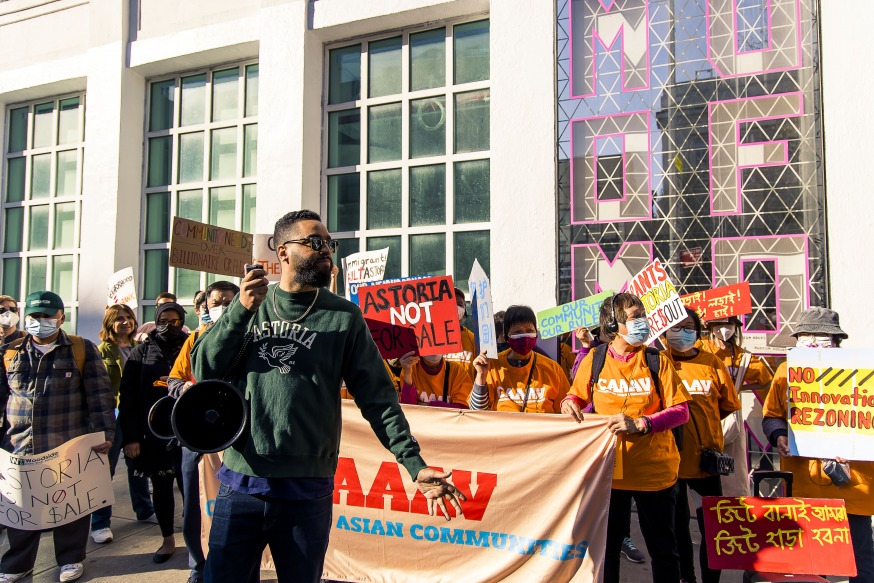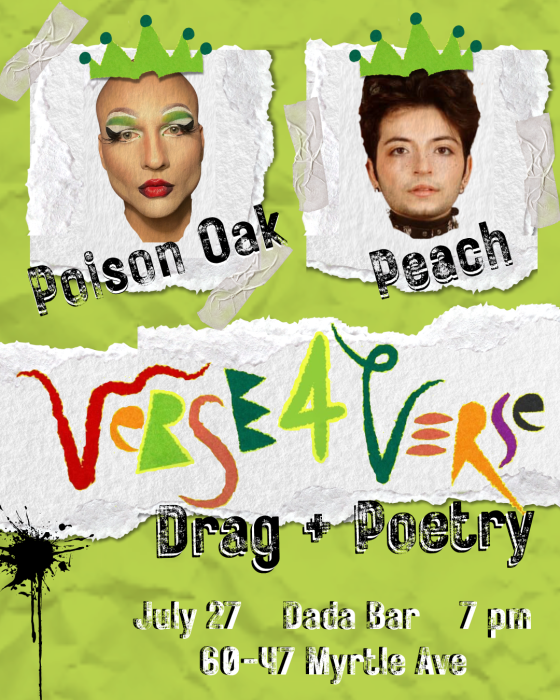
Photo from the rally outside the developers town hall held in April. (Photo: Astoria Not For Sale)
May 25, 2022 Op-Ed
We are tenants, immigrants, activists, homeowners, formerly houseless, artists, parents, small business owners, community organizers, and more. And we say: Astoria is Not for Sale.
For too long, real estate has dominated the land use conversations and development of our communities, especially in working class neighborhoods being gentrified. Now, Astoria is facing the behemoth Innovation QNS project.
What exactly is Innovation QNS? It’s a massive 5-block rezoning with majority luxury housing (75%), the bare minimum of mandatory inclusionary housing (MIH) at 25%, and most likely in the end, tax breaks for the billionaire Larry Silverstein’s Silverstein Properties, Kaufman Studios, and BedRock Real Estate Partners, who tout this area as underutilized. With 17 luxury buildings including several at 26 and 27 stories, it is completely out of scale with the surrounding community, marginalizes the immigrant and working class communities who live within and near the rezoning map, and illustrates the major flaws in our city planning processes.
According to the City’s own racial equity planning tool, it is smack dab in the middle of one of the most vulnerable areas of Astoria where approximately 25% live below the poverty line, and residents are at an intermediate to higher risk of displacement. When you dig deeper, those with the highest risk are immigrants, working class, and lower-income people of color whose earnings will not even allow them to qualify for most of the “affordable” units, let alone luxury rate studios at $3000+/month.
Our community is at a crossroads. For decades, every rezoning requested in Astoria by developers has been ultimately approved, expensive luxury housing has proliferated, and we’ve seen more and more of our most vulnerable neighbors get pushed out and displaced. While every Queens Assembly District saw their populations become or stay “majority minority”, Astoria saw the opposite in the last Census, and the driver has been gentrification.
Now everyone deserves a decent, safe, affordable, and welcoming place to live, no matter what their background. Each wave of arriving immigrants, families, workers, young people and professionals has joined the fabric of one of the most diverse neighborhoods in the City. Change is a natural part of this process. But Innovation QNS is not simply change; it is an all-out assault.
The term “underutilized” has often been used by big real estate to justify grossly inappropriate development and erase the communities that will be most impacted. It creates a dangerous narrative that for-profit developers are “saving” neighborhoods, but from Williamsburg to LIC, we see that they don’t provide what working class communities desperately need. The required meager “affordable” MIH housing is inaccessible to those who need it most, due to minimum income qualifications. Proposed community benefits are non-binding and there is no accountability.
It’s a myth that these luxury developments can solve our housing crisis and homelessness through supply and demand. Luxury apartments have higher rates of vacancy and have led to rising rents. Luxury developers used words like “vibrant” and “sustainable” when proposing their development, while ignoring the street vendor who currently parks their cart in a warehouse, the baked goods factory that supplies the local restaurants, or the immigrants who already call this neighborhood their home. They say the area is unwelcoming and use coded language to imply it’s unsafe. In this case, the developers themselves have helped create some of the very “underutilized” conditions they want to address, by holding properties off the rental market and forcing out existing businesses.
For years, Silverstein Properties, Kaufman Studios, and BedRock have been buying up and leasing properties in this corner of Astoria, which is surrounded by lower income, immigrant, and working class people and is a mix of industrial, manufacturing, rent stabilized and de facto affordable housing. In the process, they have stopped renewing commercial leases for many of the blue collar and small businesses there and admitted they have had no tangible plan to relocate them.
They have left properties vacant or filled them with studio equipment where there should be storefronts. The whispers of this rezoning have been heard for nearly a decade, and on nearby Steinway Street, where dozens of storefronts have been vacant since pre-pandemic, we’ve seen landlords forego leasing to mom and pops as they wait to see what rents they can command with a project like Innovation QNS down the pike.
They will create high-end retail space (and they won’t disclose projected starting rents); this space won’t be for the mom and pop entrepreneurs of Astoria. It will homogenize our community, and price out our halal butchers, our bodegas, our local coffee shops, and our immigrant-run restaurants.
There are many other problems with this development: open space is technically publicly accessible, but is mostly tucked away within the development; thousands of more cars on the road will threaten safety and air quality; non-profit leaders who don’t even live in Western Queens support it and receive donations, contracts, and potential space; no new schools; no detailed information in writing about breakdowns, actual rents and minimum earnings requirements for MIH unit eligibility; and more. The Environmental Impact Statement has identified at least six areas where there will be a significant negative effect on the community. The mitigation details are vague and hollow.
But ultimately, it comes down to people and displacement. It comes down to who is included in the conversations. It comes down to who has power.
Innovation QNS has spent enormous amounts of money on paid ads and marketing and has hired the biggest lobbying firm in the City, Kasirer. They have shelled out donations and promises of space to non-profit groups, including those on whose boards they serve or whose leaders they retain as consultants. They’ve penned op-eds and issued copious press releases to spin a narrative, but we are grounded in reality, not their whitewashed (and greenwashed) fantasy.
Their community outreach has been curated and controlled, and only when Council Member Julie Won criticized the lack of engagement of Bangladeshi, Spanish speaking, and working class communities in the area, did they hold a “Town Hall”—during Ramadan, Orthodox Easter week, and public school spring break. And after an overwhelmingly negative response at this Town Hall, the Innovation QNs developers went ahead and certified this project anyway: are they listening to the community? They’ve held focus groups with hand-selected participants but become incredulous when they are criticized publicly. Their website lacked Bangla and hastily inserting a google translate toggle for translation upon being called out provided laughable results. Except this is not a joke.
The local mosques, church communities, small businesses, and residents most affected by this proposal told us they were never contacted. It wasn’t until recently that the developers attempted to reach out to a few of the grassroots organizations in the area that fight for housing justice, food security, and immigrants’ rights for “feedback”. But we know this outreach is perfunctory. For nearly two years, opposition to this project has been growing and vocal.
This project must be voted down because it is wrong and not what we need. Negotiating will only get us crumbs, and the underlying flaws of this massive luxury development will remain in place and have a ripple effect across this entire area. We won’t sell out our communities and our electeds must not either, because Astoria is not for sale.
Signed,
Astoria Not for Sale
Astoria Tenant Union
Astoria Welfare Society
CAAAV: Organizing Asian Communities
The Connected Chef/Lifeline Groceries
Hope Church Astoria
Justice for All Coalition
Western Queens Community Land Trust
Woodside on the Move
And over 1900 petition signers
6 Comments







This city and country has been long sold to the highest bidder aka PRC and similar or in some rare cases also Middle Eastern tribe states. The economic world war has lended with the country of workaholic consumers sold off to the winning side, most just dont know it yet but they will learn in the coming decades.
The opposition to this proposal last night was heated and informed. Things discussed: identifying the project as speculation for air rights, the displacement to already rent burdened residents of the area, the pattern of nonresponse to items requested for review in the ULURP process, and the lack of trust the community has based on the actions already taken by Kaufman Studios privatization of 36th Street. One speaker resident called out the proposal is purely about air rights. Merchants on the 36th avenue corridor from 31st- Steinway street have been told the plan is to demolish everything along that corridor and build condo housing. The legally mandated affordable housing offered is merely 25% of the proposal, which is not what is needed in this area. In addition, the income threshold being used for entry to the lottery for those units, is in direct conflict with the American Community Survey income by area demographic. Also of note, is the mean income being used in the study area is above the actual data collected in the recent ACS survey, which shows 59% of the study area falls below the MIH being used for the project certification.
Most notably the architect, Eran Chan, while presenting the project slidedeck, was caught out unable to identify the projects blocks by sight on screen. Community members called out the identification of the blocks involved remarking “That is [name of block presented on the slide deck], we know because we live here”.
To vote against this project, sign the Astoria is not for Sale petition, write a letter to Community Board 1 Queens, contact Julie Won’s office, the Queens Borough President, the City Planning Commission and Mayor Eric Adams to vote No on Innovation QNS.
The “residents” of the area covered by the project are predominantly parked cars and a few businesses. This area IS underutilized. It is on top of a subway stop with quick access to the city. It is a bunch of very low-rise buildings. The reason this real estate is so undervalued (allowing people who otherwise could not afford to live this close to the city) is because it is underdeveloped.
Wait, so no to “gentrification” but also in the same breath “everyone deserves a safe environment?”
Are these people new to New York City? NYC has always been for sale, always will be. Stop chasing Wind Mills.
Being anti-housing does not help anyone.